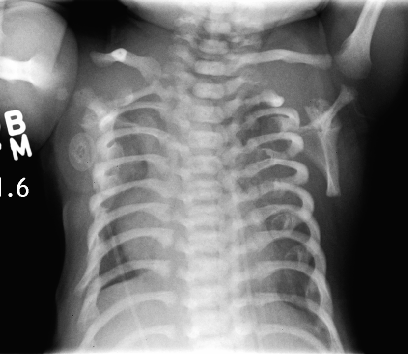Short-Rib Thoracic Dysplasia 13 With Or Without Polydactyly

A number sign (#) is used with this entry because of evidence that short-rib thoracic dysplasia-13 with or without polydactyly (SRTD13) is caused by homozygous mutation in the CEP120 gene (613446) on chromosome 5q23.
Biallelic mutations in the CEP120 gene have also been reported in patients with Joubert syndrome (JBTS31; 617761).
For a general phenotypic description and discussion of genetic heterogeneity of short-rib thoracic dysplasia with or without polydactyly, see SRTD1 (208500).
Clinical FeaturesShaheen et al. (2015) described 4 unrelated infants, 3 male and 1 female, with short-rib thoracic dysplasia and polydactyly (SRTD). Two were born of first-cousin Saudi parents, and 1 was born of Swiss parents who were not known to be related but came from the same village; the ethnic or geographic origin of the fourth patient was not noted. All 4 of the affected infants died of respiratory failure within the first week of life, and all had a small thorax with short horizontal ribs, dysplastic pelvis, short long bones, and preaxial polydactyly or synpolydactyly. Extraskeletal features included increased renal echogenicity on postnatal ultrasound in 1 patient, hypoplastic cerebellum in 1, and molar tooth sign in 1. In 1 family, there had been a previous intrauterine death of a fetus with skeletal dysplasia and preaxial polydactyly, and in another family, there had been 4 consecutive miscarriages. Shaheen et al. (2015) designated the phenotype of the patients as Jeune asphyxiating thoracic dystrophy (JATD).
Roosing et al. (2016) reported a male fetus of Flemish origin (SW-476410) diagnosed in utero with tectal and cerebellar dysraphia with occipital encephalocele (TCDOE) that was considered to be 'in the spectrum of Joubert syndrome' due to the presence of a suboccipital encephalocele, dysplastic tectum, severe hypoplasia of the cerebellar vermis, and the molar tooth sign seen on fetal MRI at 23 weeks' gestation. Postmortem examination revealed cleft palate, narrow thorax with short ribs and secondary lung hypoplasia, and discrete rhizomelic shortening of the limbs. Liver and kidneys were normal and there was no polydactyly. Roosing et al. (2016) also studied a male fetus of Turkish origin (MKS-2930) initially diagnosed with Meckel syndrome (see 249000) in the second trimester of pregnancy, due to the presence of cystic dysplastic kidneys, occipital encephalocele, and polydactyly. Postmortem examination after pregnancy termination revealed a narrow bell-shaped thorax with short ribs, rhizomelic limb shortening, bowing of long bones, microphthalmia, orofacial defects including lobulated tongue with multiple frenula and cleft soft palate, ambiguous genitalia, and anal atresia. Liver findings were not available. Of 3 previous pregnancies in the Turkish family, 1 ended in miscarriage and 2 in stillbirths.
MappingUsing DNA from affected and unaffected members of 2 consanguineous Saudi families with SRTD, Shaheen et al. (2015) performed SNP-based autozygome analysis and identified an identical shared haplotype on chromosome 5 (chr5:121,129,268-123,737,922). Genomewide linkage analysis of these 2 families and 2 additional SRTD families, all carrying the same CEP120 mutation (see MOLECULAR GENETICS), revealed a single linkage peak on 5q23.2 with a 3.6 lod score.
Molecular GeneticsIn 2 consanguineous Saudi families with SRTD mapping to a 2.6-Mb critical locus on chromosome 5, Shaheen et al. (2015) performed whole-exome sequencing and identified homozygosity for a missense mutation in the CEP120 gene (A199P; 613446.0001) that segregated with disease in both families. The variant, which was present in heterozygous state in 1 of 1,294 Saudi alleles tested and in 2 of 12,000 alleles in the Exome Variant Server database, was not found in the 1000 Genomes Project database; Shaheen et al. (2015) concluded that the very low frequency (minor allele frequency (MAF) = 0.00023) was compatible with the mutation being causal of a rare phenotype like SRTD. Screening of 109 additional affected individuals revealed 2 additional probands, including 1 born of Swiss parents, who were homozygous for the A199P mutation in CEP120. Haplotype analysis of the 2 Saudi families and the Swiss family showed shared runs of homozygosity of 714,139 bp, indicating that the mutation originated from a common founder and was most likely very ancient, consistent with the different ethnic and geographic origins of the families. The parents in the fourth family harbored the same CEP120 mutation on the same haplotype background in heterozygous state; DNA from the proband was unavailable.
In a male fetus of Flemish origin (SW-476410) exhibiting SRTD without polydactyly and with neurologic features including the molar tooth sign, Roosing et al. (2016) performed exome sequencing and identified compound heterozygosity for mutations in the CEP120 gene: the previously reported A199P mutation and a nonsense mutation (R151X; 613446.0002). By exome sequencing in another fetus of Turkish origin (MKS-2930), initially diagnosed with Meckel syndrome but also showing features of SRTD with polydactyly, Roosing et al. (2016) identified homozygosity for a missense mutation in CEP120 (I949S; 613446.0003). Contrasting the severity of the phenotype in these patients with the relatively mild, purely neurologic phenotype in 4 patients with CEP120-associated Joubert syndrome (JBTS31; 617761), Roosing et al. (2016) stated that the mechanism through which mutations in the same gene cause such wide phenotypic variability remained unexplained.